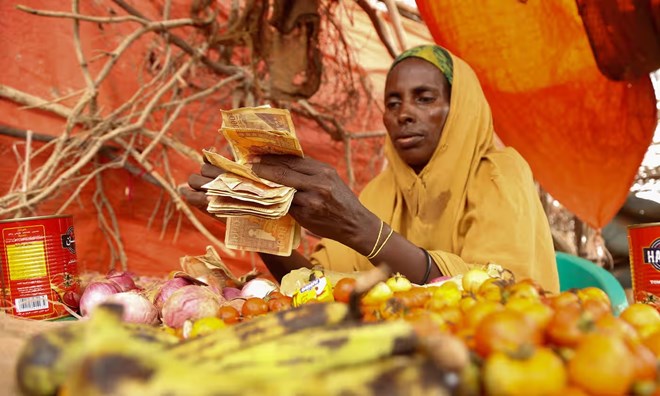Wednesday December 13, 2023
By: President Hassan Sheikh Mohamud

A grocer counts her money at her stall at the El-Jale camp for the Internally Displaced Persons in Beletweyne, Somalia. Photograph: Alamy
As Somalia secures $4.5bn of debt relief from the IMF and the World Bank, the country’s president outlines the decade-long path it took to reach this goal – and looks towards a better, if still difficult, future
Debt relief is just the beginning of real change for Somalia. The country has been suffocating under the huge weight of unsustainable debt for more than three decades. Between 2012 to February 2017, when I led the first internationally recognised government since the collapse of the state in 1991, we realised quickly that we had to re-engage with all the international financial institutions and our bilateral and multilateral creditors to address this crippling impediment to our economic development.
Somalia owed more than $5bn (£3.9bn). And the interest and charges on these debts kept mounting. As a new government in a post-conflict state, fighting international terrorism, but with the ambition to rebuild Somalia, we had to act.
There was no way to repay the debt given the deep-rooted economic challenges facing our fragile country. Accordingly, we embarked on a rigorous but fruitful debt relief journey through the Highly Indebted Poor Countries Initiative (HIPC) with the International Monetary Fund (IMF), which required the Somali government to undertake significant and challenging yet strategic macroeconomic and social reforms to address institutional weaknesses, enhance public trust in government, transform the economy and create opportunities for our people.
Somalia’s debt relief journey was no simple task; it took nearly a decade, three different administrations, two presidents and four finance ministers to attain debt relief from the boards of the World Bank and IMF on 13 December.
Ironically, in Somalia’s highly active and competitive political landscape, achieving debt relief was one of the key unifiers of political actors of all persuasions. Furthermore, the process ensured there was a systematic review by the Somali government and people of their own economic history, fiscal borrowing and the socioeconomic destruction of almost three decades of civil war. In fact, most of Somalia’s unsustainable debts is accrued interest payments that could not be serviced during the painful, prolonged period of state collapse.
It is heartening to know that in all the years of implementing Somalia’s economic reform programme, we have not backslid once, despite enormous security and cyclical climate crises. In this regard, it is important to recognise the support of all of Somalia’s valuable bilateral and institutional partners who worked closely with us to provide technical assistance, budget support, advice and even encouraged our progress on the international stage.
For the different political administrations in Somalia that were implementing the tough global programme to rebuild our economy while living with major terrorism and climate disruptions, this was appreciated. A key lesson from Somalia’s debt relief journey is that engaged and supportive international partners who are ready to listen and work with developing nations on their priorities will help to accelerate reforms in any context.
Escaping Somalia’s huge debt burden has many benefits. We have normalised relations with former creditors and can now access new concessional financing where required for development investment, as we continue to strengthen fiscal fundamentals with the reform lessons learned.
We have proven to ourselves and to international partners that we can reform and shift away from the detrimental stigma of “failed state” to a new reality of hope and possibilities. However, despite these clear successes, a key challenge, as for other countries that benefited from debt relief in the past, is debt sustainability and management in this age of global economic slowdown and recurring shocks.
Somalia will still have moderate but sustainable debt levels. We plan to escape a return to the debt trap by utilising our strategic location, young population and vast natural resources to grow our economy. We are focused on attracting investment in all our key competitive areas – agriculture, livestock, green energy and the blue economy – to create opportunities and jobs to build socioeconomic and climate resilience. This is enhanced by our recent membership of the East African Community, which should open new markets.
In an age of interconnectivity and interdependence, fragile states like Somalia should not be left alone to bear the cost of financing global challenges such as the impact of global terrorism and climate change. Addressing these is a global public good and more accessible and predictable financing must be available to facilitate not just immediate short-term stabilisation and mitigation measures, but also long-term, scaled-up adaptation and community responses.
This is the only realistic way to ensure that countries like ours do not constantly have to make trade-offs between investing in vital basic public services and addressing a climate crisis to which we, with our limited resources, barely contribute. If we are to ever achieve sustainable development, there must be serious conversations on equitable burden sharing for financing development internationally.
Somalia has finally reached the debt relief milestone. This is a moment for our government and people to be proud. However, we also know that the hard work of sustaining economic reform and creating progress for our people has just started – amid the most difficult international economic environment.